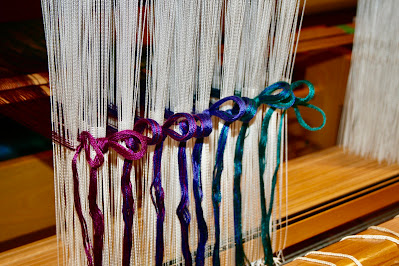This post has been a while coming and the shawls shown here today mark the end of 16 years of imagining, planning, weaving and finishing scores of projects on my Spring Loom. In all that time, she was never empty and always had something on the go. A delight to weave on and frankly, hard to let go.
Truth be told, it was time as my health has undergone some changes in the past 2 -3 years and it's time to weave less and be under less pressure to keep two looms going and an Etsy shop full. I don't know how weavers with multiple looms do it as there is only one weaver to keep all the balls in the air!
I still have my Megado and will still weave but my back tells me when its okay... when and how much. Its Boss. Simple as that...
So this first shawl has an undyed 10/2 tencel warp. I bought some back when Webs used to carry it as it's a great staple to have on hand. I used a 28 epi sett and my new 14 dent reed I got for Christmas in 2023 and it had patiently waited in its plastic sleeve.
I find that setts where its 2 threads per dent show reed marks less. If you double or triple them up then it's going to show up. Not all reed marks will wash out either. So, an investment in a new reed was a good idea when I checked my stash and saw how much 10/2 cottons I have on hand 😳
The weft is a rose fiber yarn that I bought from Hilary at Crazy as a Loom (she may have more?) Technically it's 'natural' but it does have a slight peachy hint of colour. Neutral but something is going on there.... I like it!
The draft is an 8 shaft huck lace which always looks better with 'tone on tone' colours. The tie up stayed in place and the looms new owner wove a scarf or two. It gave her time to get to know the loom before she had to tackle changing a CM tie up. Which she did with her next project and quite well too.
I wanted to try my hand at some fancy smancy borders and thought to give Danish Medallions a try. I pulled them tight to for the ovals and didn't like what it did to the overall light-weight cloth. So I just snugged them into place and they appear as an interesting feature as you can see from the picture above. They are a slow hand manipulation but very pretty and I'll try them again soon.
Above you can see the drape and trust me, it's a light weave with a very soft touch. Rose yarn is lovely to work with. Below you can really see the peachy tint. 🍑 🌹
... and now for another garden extract..... Dandelion!
When the time came to start the second shawl, I dug into the stash cupboard and found something interesting choices. I had a cashmere blend but it was much too fine. Then I found mint fiber which was soft but while neutral, it still looked a greyed white. I opted for a cone of dandelion fiber yarn instead as it had the right colour and silky look and feel to it I was looking for. { I bought it at an Etsy shop called "YarnItaly" and they carry an ever changing inventory of exotic yarns }
Your can see the results as it looks like a white ivory and where there are weft floats there is a lovely sheen that catches the light. I might keep this one for me. Or maybe not since we need a new heat pump.
Again lovely drape and you can see how light the fabric is. It would be like wearing a cloud! ☁️
The border treatment this time was to mix up the huck treadling and create a band of pattern. It was certainly faster than Danish Medallions.
I tried taking the pictures outside but the huck lace vanished in the sunshine. Inside was much better but my flash unit wouldn't work so I had to brighten these on the computer. Technology to the rescue...
So let me sow some seeds for thought: You may be really keen to weave but please think about your overall posture at the loom, getting the right sized loom for you, and the right bench height. Your elbow should be at a right angle and rest comfortably on the breast beam when you sit.
Then think on time management: only fill 1-2 bobbins so you have to get up and move, stretch. Take rest breaks. Don't weave if a body part is hurting. It's time to stop. Maybe shift to another studio job instead.
One thing I have never done in all my 30 years of weaving, is to weave at night. Daytime only. I will use lights to brighten a dark day but never weave at night when your eyes are tired and straining.
Dark colours, such as all black are only woven on a bright summer day when you can see!
Some years ago, on a dark winter day, I wove a black on black lace table runner and couldn't see if I had made an error. I had to call out the treadling order verbally to myself thought out the 50-60 inches and only after it came off and was washed could I see if I got it right. I did get it right fortunately as linen is too expensive to make that kind of mistake with!
If you think all these steps thoughtfully, then you will weave longer and be a healthier you. 💕




























































